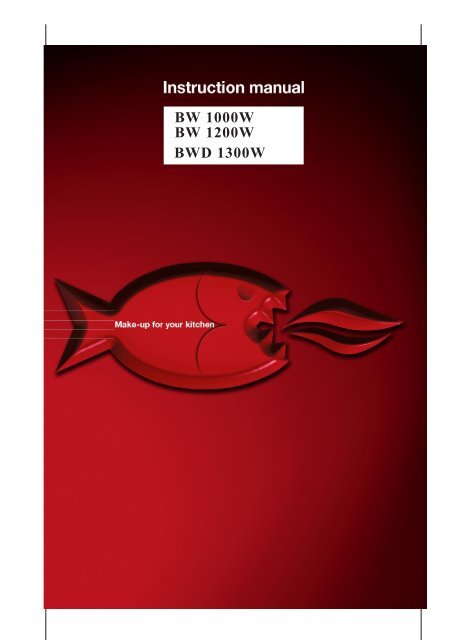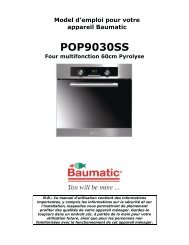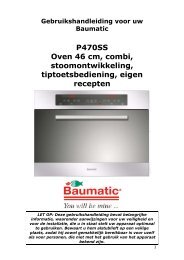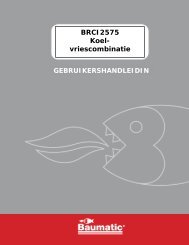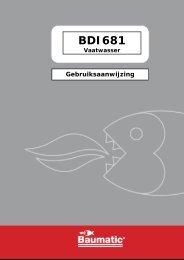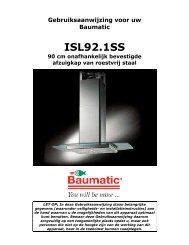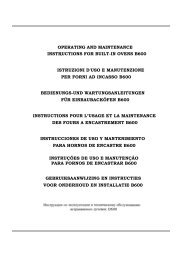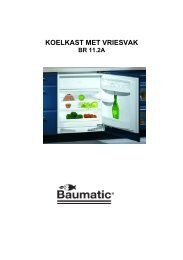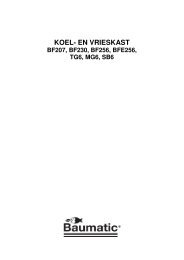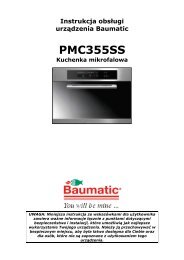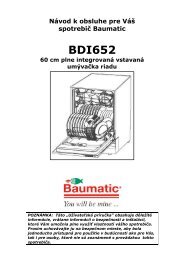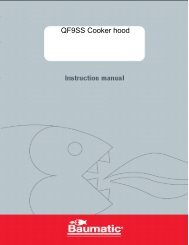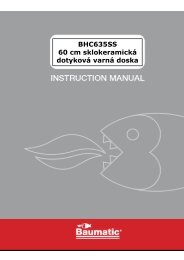Create successful ePaper yourself
Turn your PDF publications into a flip-book with our unique Google optimized e-Paper software.
<strong>BW</strong> <strong>1000W</strong><br />
<strong>BW</strong> <strong>1200W</strong><br />
<strong>BW</strong>D <strong>1300W</strong>
This appliance complies with the provisions of the 89/336/EC Directive<br />
regarding electromagnetic compatibility and the 73/23/EC directive Low<br />
Voltage regarding electrical safety and the 93/68/EC Directive for CE<br />
marking.<br />
2
INDEX<br />
1-SPECIFICATION<br />
2- INSTALLATION<br />
3- HANDLING<br />
4- MAINTENANCE<br />
5- CAUTIONS AND ADVICE<br />
6- SAFETY FEATURES<br />
7- CONTROLS<br />
8- WASH PROGRAMME TABLE<br />
3
1 - SPECIFICATION<br />
1.1 - Technical data<br />
Wash/Dry<br />
- Dimensions...........................................Height..................................85 cm<br />
Width...................................60 cm<br />
Depth...................................55 cm<br />
- Washing/Drying capacity.......................Cotton.....................5,5 kg/2,75 kg<br />
Synthetics...............2,75 kg/1,5 kg<br />
Wool...........................1 kg<br />
- Power supply voltage (m.f.)...............................................230 V ~ 50 Hz<br />
- Maximum power consumption-washing/Drying................2.200 W/ 1.450 W<br />
- Models............................................................................<strong>BW</strong> <strong>1000W</strong> <strong>BW</strong> <strong>1200W</strong> <strong>BW</strong>D <strong>1300W</strong><br />
- Spin speed........................................................................ 1000 1200 1300 rpm<br />
- Energy consumption, cotton 1 cycle of wash........... 1,03 1,03 1,03 kWh<br />
wash at 60ºC (without pre-w.) { 200 cycles of wash...... 206 206 206 kWh<br />
- Water consumption, cotton<br />
wash at 60ºC (without pre-w.)<br />
- Energy consumption, drying (cotton 2,75 kg)...................................2 kWh<br />
- Water consumption, drying (cotton 2,75 kg)........................................50 l<br />
- Energy consumption 1 wash cycle + drying .................................................5,03 kWh<br />
wash + 2 drying cycles { 200 wash cycles + drying..........................................1.006 kWh<br />
- Water consumption 1 wash cycle + drying..................................................150 l<br />
wash + 2 drying cycles { 200 wash cycles + drying.........................................30.000 l<br />
1.2 -Description of the washing machine & Washer-Dryer<br />
B- Detergent drawer<br />
H- Filter door<br />
I- Adjustable feet<br />
Ap. 7 CONTROLS<br />
U- Door opening handle<br />
P- Programme selector<br />
T- Temperature selector<br />
S- Drying time selector<br />
V- Spin speed selector<br />
L- Pilot lamp<br />
A- Rinse hand hold push-button<br />
B<br />
C- No spin push-button<br />
U<br />
M- Half load push-button<br />
R- 550/1000-1300 rpm push-button<br />
X- ON/OFF push-button<br />
H<br />
Y- Extra rinse push-button<br />
4<br />
I<br />
{<br />
1 cycle of wash...........<br />
200 cycles of wash.......<br />
49<br />
9.800<br />
49<br />
9.800<br />
49 l<br />
9.800 l
2- INSTALLATION<br />
2.1 - Removing transit bolts<br />
A<br />
B<br />
C<br />
2.2 -Plumbing connection<br />
After removing the external packing<br />
the drum must be released before the<br />
machine is used.<br />
This is done in the following manner:<br />
1.) Unscrew and remove the four<br />
screws A-B-C-D.<br />
2.) Push with a screwdriver at an angle<br />
in the screw holes until the four spacers<br />
(H) fall.<br />
These must be recovered and kept.<br />
3.) It is very important to recover these<br />
four spacers (H) because they could<br />
cause damage if they remain inside the<br />
machine and also because they will be<br />
required to move the machine in the<br />
case of moving house.<br />
The user will require a tap with a 3/4" gas screwthread outlet and a drain<br />
situated between 50 and 80 cms. above floor level. The watermain pressure<br />
must be between 0,4 and 10 bar inclusively.<br />
Proceed as follows:<br />
-Let the water run for a while before connecting the hose.<br />
-Connect the water inlet hose applying the rubber joint provided in the fittings<br />
equipment bag.<br />
-Position the drainage hose inside a hose of a larger diameter, or rest it well<br />
fastened against any kind of drain at the height indicated.<br />
-Neither of the hoses should be twisted or kinked.<br />
- Use new tubes for connecting to the water supply.<br />
Max.80 cm.<br />
D<br />
Min.50 cm.<br />
H<br />
H C<br />
THERMO<br />
H<br />
C<br />
C- Cold water connection.<br />
H- Hot water connection.<br />
The "H" connection can only<br />
be applied in those machines<br />
fitted for this (Bithermical).<br />
5
2.3 - Levelling<br />
For the appliance to work under optimum conditions, it needs to be levelled<br />
perfectly, i.e.horizontal and stable.<br />
Once the machine has been positioned in ist<br />
place, work the adjustable feet "I" at the<br />
front of the washing machine, until it is<br />
horizontal and the four feet are resting<br />
firmly on the floor.<br />
Once the levelling is done, block the<br />
J adjustable feet by tightening the nut "J".<br />
In order to prevent noise and vibration,<br />
ensure that the machine is not touching any<br />
nearby walls or furniture.<br />
I Make periodic checks that the machine is<br />
levelled by repeating these operations if<br />
necessary.<br />
2.4 -Electrical connection<br />
Before connecting the washing machine to the power supply, the following<br />
points should be checked through:<br />
6<br />
That the power supply, is single-fhase 220-<br />
230 V ~ (230-240 ~ for UK).<br />
That the user's meter, limiter, fuses, power<br />
socket and installation are of an adequate<br />
output for the power indicated on the<br />
characteristics plate of this washing machine.<br />
10 A 250 V fuse (13 A 250 V for UK).<br />
Use a wall socket with an earth connection.<br />
The wasing machine's plug guarantees the<br />
machine's earthing.<br />
If the wall socket does not have an earth<br />
connection, you must connect the central<br />
earth connection of the washing machine to<br />
good ARTIFICIAL EARTH (consult your<br />
dealer).<br />
THE WASHING MACHINE MUST BE WELL EARTHED.<br />
The manufacturer declines all responsibility for any accidents on ocurrences<br />
caused by a defective earth connection or lack thereof.<br />
NOTE: If the power supply cable is damaged, it should be substituted by<br />
a specially prepared replacement cable, to be supplied by the<br />
manufacturer, or by the official after salesTechnical Service Organisation.
3- HANDLING<br />
3.1 - Loading door-Opening<br />
Once the washing programme has finished, push the programme button (or<br />
ON/OFF push-button) and wait 2 minutes before trying to open the door.<br />
A<br />
B<br />
1<br />
3.2 - Detergent drawer. Distribution of the washing products.<br />
1 2 3 4<br />
CASE A: 1. Press the hidden lever with the index and<br />
middle fingers 1<br />
2. Pull outwards.<br />
CASE B: Pull the door lever outwards.<br />
WARNING: When the door is open, the power supply<br />
is cut and the machine will not operate.<br />
To open the drawer, put your and in the lower part of<br />
the soap drawer and pull it outwards.<br />
SECTION 1 - Pre-wash soap (50 gr.Max.).<br />
SECTION 2 - Main wash soap (125 gr.Max.).<br />
SECTION 3 - Bleach (80 ml. Not concentrated).<br />
SECTION 4 - Softener (80 ml.Max.).<br />
Never put more than indicated by the lever in the soap<br />
drawer.<br />
The ideal dose of detergent depends on the hardness of<br />
the water, how dirty the clothes are and the load.<br />
(Consult the soap manufacturer's instructions).<br />
Make sure that the material can support the treatment<br />
with bleach if it is used.<br />
7
3.3 - Selecting the clothes load<br />
Before putting the clothes into the machine, you should:<br />
Separate the clothes into three lots (cotton, synthetics and wool).<br />
Within each group, separate the coloureds from the whites.<br />
Once the clothes have been sorted, put them into the drum of the machine,<br />
separately according to colour and group, loose piece by piece, as per the<br />
following proportions:<br />
Cotton maximum 5,5 kg.<br />
Synthetics maximum 2,75 kg.<br />
Wool maximum 1 kg.<br />
3.4 - Selecting the right program<br />
Once the clothes have been sorted into fabric types and colours, you need to<br />
select the right program and temperature. SEE PROGRAM TABLE (Section 8).<br />
3.5 - Starting operation<br />
With the machine now loaded, the door closed, the soap drawer compartments<br />
filled and the right program chosen, to start the machine, you just need to<br />
PULL OUT THE PROGRAMMER CONTROL BUTTON (P) OR ON THE<br />
PUSH-BUTTON (X).<br />
The machine automatically goes through all the operations included in the<br />
wash cycle until it ends.<br />
The wash is now ready to be hung out dry (or to be ironed in the case of<br />
washer - dryers).<br />
3.6 - How to get the best performance<br />
3.6-1 - Maximise the load (Section 8)<br />
You obtain the most efficient use of energy, water, detergent and time by<br />
using the maximum recommended load.<br />
You save 50% energy by washing one full load instead of two half loads.<br />
3.6-2 - Do you need a pre-wash?<br />
Only for deeply stained laundry !.<br />
You save detergent, water, time and between 5 to 15% of energy through<br />
not using the pre-wash for light and normally soiled clothes.<br />
3.6-3 - Do you need hot water?<br />
Soak or treat stains before the wash, in order to reduce to need to use the<br />
hot programme.<br />
You save 50% energy by using the 60ºC programme.<br />
3.6-4 - For washer-dryers: before using the dryer<br />
Select high (> 850 rpm) for the spin before drying, in order to save energy, water<br />
and time during the drying period.<br />
8
4- MAINTENANCE<br />
4.1 - Cleaning the drain-pump outlet filter.<br />
It is advisable to periodically clean this filter (every 25 wash cycles) in order<br />
to maintain the correct operation of the drain pump and consequently, the<br />
washing and rinsing efficiency.<br />
In order to clean the filter carry out the following:<br />
-Open the access door. (A). Place a container to catch<br />
any water.<br />
-Unscrew the cap (B) until it is loose, but do not<br />
remove the cap completely. Pull out the filter.<br />
After cleaning, re-insert the filter with the cap still<br />
loose.<br />
Now retighten fully and check for water leaks.<br />
-There is only one way that the filter will slide<br />
into its housing.<br />
A<br />
B<br />
4.2 - Cleaning the inlet valve filter.<br />
CLEAN<br />
4.3 - Cleaning remains of detergent.<br />
AVOID<br />
DO NOT USE FORCE<br />
Any impurities in the water supply are deposited<br />
in the filter at the inlet to the inlet valve.<br />
To clean this filter:<br />
a) Turn off the water tap.<br />
b) Unscrew the water inlet hose at the washing<br />
machine end.<br />
c) Remove the filter using pointed pliers and<br />
clean it.<br />
d) Reverse the procedure to re-attach the hose.<br />
Overfilling the prewash and main wash<br />
compartments with too must detergent causes the<br />
excess to be deposited inside the collector, and<br />
could, over time, cause water to leak through the<br />
entrance of the detergent drawer.<br />
To clean the deposits, remove the soap drawer by<br />
pulling it outwards, and clean it thoroughly.<br />
9
5- CAUTIONS AND ADVICE<br />
In order to get maximum satisfaction and performance from this appliance, it<br />
is important to follow the instructions indicated below:<br />
This washing machine is exclusively for domestic use.<br />
10<br />
Select the clothes load correctly (section 3.3) and choose the appropriate<br />
programme (section 8).<br />
Before starting to operate the machine, it must be released from its transit<br />
(section 2.1).<br />
Before opening the door, check that there is no water in the machine and<br />
the pilot light is off.<br />
Plug the power supply plug into a socket with an EARTH CONNECTION<br />
and at the correct voltage.<br />
Put in the washing products in the right proportion and the right<br />
compartment (section 3.2).<br />
Small garments, such as socks, belts, etc. are best put inside a bag to avoid<br />
them being lost.<br />
Before putting clothes into the washing machine, make sure that there is<br />
nothing in the pockets (coins, buttons, clips, etc.) and that zips are undone.<br />
If your machine has a filter, you should periodically check it is clean (sec. 4.1).<br />
The interior of the washing machine should be handled by specialist only.<br />
After each wash,leave the door ajar to prevent the rubber seal from becoming<br />
misshapen.<br />
When the clothes to be washed are heavily soiled or splattered with mud, it<br />
is advisable to run a program with prewash.<br />
Always put the machine on full, to save energy.<br />
When the machine is installed, or after a long time without it being used, it<br />
is advisable to run a wash program with the machine empty, to eliminate<br />
any rusty water in the tubes.<br />
For washer-dryers, do not use the dryer function if the clothes have been<br />
treated with any non-aqueous solution.<br />
Also for washer-dryers,do not use the dryer function for items containing<br />
spongey rubber or similar elastomer materials.<br />
The dryer must be installed in a well-ventilated place, away from the<br />
influence of gases from other appliances and from defective installations.<br />
The lower ventilation, between the floor and the base of the machine, must<br />
not be obstructed (by carpet, cloths, etc.).
In the event of any doubts or anomalies which arise, ring the TECHNICAL<br />
ASSISTANCE SERVICE, but first, make the following checks:<br />
a) The machine is not working. Check that:<br />
- The door is properly closed.<br />
- The fuses are not brown and the automatic cutout has not been triped.<br />
- The programmer control button P (or the push-button X) is not in the STOP<br />
position.<br />
b) The machine is not filling with water. Check that:<br />
- The tap is open and the pressure is sufficient.<br />
- The electrovalve filter is not clogged (Section 4.2).<br />
- The filling hose is not kinked.<br />
c) The machine will not drain or spin.Check that:<br />
- The drainage hose is not kinked.<br />
- The drainage pump filter is not clogged.<br />
d) The machine is filling with water and draining at the same time.Check that:<br />
- The drainage hose is positioned at the right height (Section 2.2) and that it<br />
is not syphoning because the diameters of this hose and the drain where it is<br />
resting are very tight.<br />
e) The machine is vibrating or making a lot of noise. Check that:<br />
- The block release operation has been carried out (Section 2.1).<br />
- The washing machine is properly levelled (Section 2.3).<br />
- The washing machine is not vibrating due to contact with furniture or a wall.<br />
f) The machine is leaking water. Check that:<br />
- The filter cap is tightly closed and with the trim in ist place.<br />
- The inlet hose is tightened on both sides and with the trim in ist place.<br />
- The detergent used is loose powder and is not forming lumps which clog the<br />
soap drawer.<br />
- The washing machine is well levelled and not leaning forwards.<br />
g) The machine is not washing to your satisfaction. Check that:<br />
- You have chosen the right temperature an program.<br />
- You are using the right dose of detergent.<br />
- The filter is not clogged and so the rinses are not working properly.<br />
h) If the loading door will not open, remember that:<br />
- The pilot lamp (if there is one) must be off. If it is not, press the button to<br />
the STOP position and wait about two minutes before trying to open it.<br />
If after making these checks, the doubts or abnormalities continue, then<br />
call our Technical Assistance Service who will attend to you as soon as<br />
possible.<br />
11
6- SAFETY FEATURES<br />
6.1 - The door<br />
An electro-mechanical safety device prevents the door from<br />
opening whilst the appliance is operating,thus preventing access to the inside<br />
of the machine and the consequent danger of injuries to the hands from coming<br />
into contact with high temperatures or from the movement of the drum.<br />
THE DOOR CANNOT BE OPENED FOR APROX. 2 MINUTES AFTER THE<br />
PROGRAMME HAS ENDED.<br />
6.2 - The wash motor<br />
In the event of mechanical underload or overload,a thermal safety device<br />
automatically protects the motor.<br />
6.3 - Heating<br />
Heating of the wash water cannot start until the required water level is reached.<br />
If there is not enough water or the tap is off,the machine stops (the program<br />
does not move forward).<br />
A safety thermostat prevents excess temperatures.<br />
6.4 - Plumbing.Water inlet<br />
In the event of the filter being blocked the machine will never overflow.<br />
6.5 - Child safety<br />
The accesses to the door and to the pump motor filter are protected against<br />
any accidental handling by children.<br />
12
7 - CONTROLS<br />
<strong>BW</strong> <strong>1000W</strong><br />
<strong>BW</strong> <strong>1200W</strong><br />
<strong>BW</strong>D <strong>1300W</strong><br />
Y<br />
Y C X T L<br />
A<br />
Y C X S L<br />
A<br />
C X T L<br />
R<br />
M<br />
R<br />
V<br />
T<br />
P<br />
P<br />
P<br />
13
7 - CONTROLS<br />
P- Programme selector<br />
This control button is used to select the programme which is adequate<br />
according to the nature and degree of dirtiness of the clothes to be<br />
washed.To set the programme,operate the ON/OFF button (position out)<br />
and turn the control in a clockwise direction until the indicating mark<br />
coincides with the chosen programme.<br />
Starting the washing machine. Once the adequate programme has been<br />
chosen,press the ON/OFF button again (position in).The machine will<br />
start and automatically carry out all the wash functions until the end<br />
of the cycle.The programme control will turn as the different functions<br />
are carried out,until it reaches the Stop position.At this point,pres the<br />
ON/OFF button once more (position out) to disconnect the machine from<br />
the power supply and to be able to open the door.<br />
T- Temperature selector<br />
This control button allows the temperature to be chosen for the wash which is<br />
most suitable for the type of fabrics to be washed. A temperature equal to or<br />
lower than that indicated in the program table can be chosen (even cold).To<br />
select the temperature, just turn the button until it is lined up with the<br />
corresponding marker.<br />
V- Spin speed selector<br />
this control button allows us to vary the spin speed of the last minutes of each<br />
one of the cotton programmes between 550 and maximum as correspond. In<br />
this way, the machine user can choose the most convenient spin speed for the<br />
clothes. To set this speed, it is only necessary to turn the control button until<br />
the corresponding mark coincides with the desired spin speed.<br />
S- Drying time selector<br />
This control button allows the selection of drying time according to the weight<br />
and type of material. (See the programme table).<br />
Resistant materials drying: A drying cycle can be carried out at the end of<br />
the washing cycle for all the available programmes for cotton by using this<br />
button to select the adequate position as indicated in the programme table.<br />
Delicate materials drying: In the same way, a low temperature drying cycle<br />
can be selected at the end of the washing cycle for all the available programmes<br />
for synthetic materials by using this button to select the adequate position<br />
according to the programme table.<br />
14
A- Rinse and hold push-button<br />
When activated "button IN", it makes the wash cycle of the synthetic and wool<br />
programs stop during the last rinse with the drum full of water. This operation<br />
is advisable to prevent creasing in certain fabric which need to be drip dried.<br />
To end the cycle, press the button again "button OUT".<br />
In washing machines with automatic drying, never press this button.<br />
C- No spin push-button<br />
When activated "button IN", the spin is eliminated from all the programs<br />
of the machine. This operation is necessary for certain types of delicate fabrics.<br />
When this button is pressed the drying function is not operate.<br />
M- Half load push-button<br />
When activated (button IN), the machine automatically runs the programm<br />
with a considerable water saving. Recommended only when the load is less<br />
than half load.<br />
Never press for wool and synthetics programs.<br />
R- 550/1000-1200-1300 rpm push-button<br />
Selects the spin speed of the last minutes of the cotton programmes.<br />
Button OUT : the spin speed is 1000-1200-1300 rpm.<br />
Button IN : the spin speed is 550 rpm.<br />
X- ON/OFF push-button<br />
Once the adequate programme has been selected,the washing machine can be<br />
started by pressing this button "IN" and it will automatically carry out all the<br />
chosen functions until the end of the programme. (Stop position). When the<br />
push-button is pressed "OUT", the machine will not work.<br />
Y- Extra rinse push-button<br />
When it is not operated "button OUT" the machine will automatically carry<br />
out the programmes for cotton with a considerable saving of water.<br />
It is only advisable when the load is equal to or less than half load. With bigger<br />
loads it is advisable to operate this button "button IN" so that greater rinse<br />
efficiency is obtained.<br />
L- Pilot lamp<br />
When it is lit,indicates that the machine is switched on and that the door<br />
locking system is activated.<br />
In normal washing machines it goes out at the end of each programme and<br />
door lock is not activated.<br />
In washing-drying machines it stays on at the end of each programme and door<br />
lock not activated.<br />
15
PRACTICAL ADVICE<br />
a) Correctly select the load of clothes and correct programme (section 3.3 and 8).<br />
b) The temperature indicated in the programme table is the maximum which can be<br />
c) One can choose the desired temperature with the temperature selector, but always<br />
lower than that indicated in the programme table (section 8).<br />
e")The programmes for resistant materials cotton finish with a long spin, followed by<br />
a strong drying cycle.<br />
The programmes for synthetic materials finish a short spin, followed by a gentle drying<br />
cycle. They could also finish with the drum full of water (according to rinse and hold<br />
push button). To finish the cycle in this case, move the programme button one position.<br />
The wool programmes finish with a gentle spin. They could also finish with the drum<br />
full of water (according to rinse and hold push button). To finish the cycle in this case,<br />
move the programme button one position.<br />
f) All articles of clothing that bear a label with the wool symbol can be washed with<br />
complete safety with the "wool" programme of this washing machine.<br />
h) Bleach must only be used with white cotton materials.It must be non-concentrated<br />
bleach for use in washing machines and it must be put in the corresponding section of<br />
the soap drawer.<br />
i) The "EXTRA RINSE" button permits an extra rinse when it is considered necessary.<br />
j) The "RINSE AND HOLD" button only operates in the synthetic and wool programmes<br />
k) Never press the ECO 1/2 load button with the wool and synthetic programmes.<br />
IN WASHER-DRYER MACHINES: see recommendations in programme table.<br />
l) When the load is 2,75 kg. of "cotton" or lees, the machine can automatically carry<br />
out the operations of wash+dry, by simply previously selecting the adequate<br />
programme and drying position the corresponding control buttons.<br />
m) When the load is greater than 2,75 kg. the wash must be carried out with the timer<br />
control button in the "0" position.<br />
Once the wash programme has finished, remove the load from the machine and divide<br />
it into two equal parts. Carry out sucessive drying cycles with each one of these loads,<br />
selecting the adequate position with the drying time selector.<br />
n) For drying synthetic clothes, choose the corresponding programme with the programme<br />
button and select in the same way, the drying position with drying time selector.<br />
o) When the no-spin button is pressed, the drying function will not operate.<br />
p) When selecting the drying function, always use the timer on the machine itself,<br />
allowing the timer to run automatically to the Stop position "0".<br />
Never use an external timer, in order to avoid possible functional faults.<br />
16
8- WASH PROGRAMME TABLE<br />
WOOL<br />
15<br />
16<br />
17<br />
Wool Wash<br />
Rinse<br />
Gentle Spin<br />
30<br />
*<br />
0.05<br />
0.03<br />
2.00<br />
1.50<br />
1.50<br />
0.90<br />
0.70<br />
0.60<br />
0.03<br />
0.02<br />
1.00<br />
0.75<br />
0.50<br />
0.03<br />
0.02<br />
6<br />
1<br />
50<br />
30<br />
SYNTHETICS<br />
9 Fast Coloureds with pre-wash 40/60<br />
10 Mixed Fabrics<br />
60<br />
11 Eco Quick wash 50<br />
12 Delicates<br />
40<br />
13 Softener / Freshen Up *<br />
14 Delicate Spin<br />
SYNTHETICS DRYING<br />
1,5<br />
1<br />
2,75<br />
70<br />
60<br />
10<br />
6<br />
65<br />
50<br />
Wash 50 + 3 rinse + + spin<br />
Wash 40 + 3 rinse + + spin<br />
1 rinse + + spin<br />
Spin 550 rpm<br />
Gentle drying<br />
Gentle drying<br />
Wash 30 + 3 rinse + + spin<br />
3 rinse + + spin 550 rpm<br />
Spin 550 rpm<br />
110<br />
80<br />
Pre.40 + wash 60 + 3 rinse + + spin<br />
Wash 60 + 3 rinse + + spin<br />
COTTON DRYING<br />
2,75<br />
2<br />
105<br />
85<br />
5<br />
6<br />
7<br />
8<br />
40/90<br />
90<br />
60<br />
60<br />
40<br />
*<br />
*<br />
2.35 160 Pre.40 + wash 90 + 3/4 rinse + spin<br />
2.20 150 Wash 90 + 3/4 rinse + spin<br />
1.25 140 Wash 60 + 3/4 rinse + spin<br />
1.03 130 Wash 60 + 3/4 rinse + spin<br />
0.55 125 Wash 40 + 3/4 rinse + spin<br />
0.09 50<br />
20<br />
12<br />
COTTON FABRIC<br />
( )<br />
3/4 rinse + spin<br />
1 rinse + spin<br />
6' x (550-850/1000/1200/1250) rpm<br />
Energetic drying<br />
Energetic drying<br />
4<br />
1<br />
2<br />
3<br />
Whites with pre-wash<br />
Whites<br />
Heavy Cottons<br />
Fast Coloureds<br />
Delicate Cottons<br />
Rinse<br />
Softener / Freshen Up<br />
Long Spin<br />
5,5<br />
PROGRAMMES<br />
ºC.SELECTOR<br />
PRE-WASH<br />
WASH<br />
BLEACH<br />
SOFTENER<br />
LOAD kg<br />
ON/OFF<br />
NO SPIN<br />
EXTRA<br />
RINSE<br />
HALF LOAD<br />
RINSE &<br />
HOLD<br />
550/1000-<br />
1300rpm<br />
PROGRAMME<br />
DESCRIPTION<br />
PRODUCTS<br />
1 2 3 4<br />
X<br />
PUSH BUTTONS<br />
C Y M A R<br />
CONSUMPTION<br />
kWh<br />
WASHING<br />
min.<br />
17
Baumatic Ltd<br />
CONDITIONS OF GUARANTEE.<br />
Dear customer,<br />
The conditions of guarantee which apply to your Baumatic appliance are as follows: This product<br />
is guaranteed for 12 months from the date of original purchase.<br />
Baumatic Ltd will repair any defect that arises due to faulty materials or workmanship free of<br />
charge during this period.<br />
In addition, your appliance is covered by a 5 year parts warranty, Baumatic Ltd will provide free<br />
of charge the parts required to repair the appliance, only if they are fitted by a Baumatic engineer,<br />
for any defect that arises due to faulty materials or workmanship within a period of 5 years fron<br />
the original purchase date.<br />
An additional and annually renewable Insurance scheme for labour is available should you wish<br />
to extend the warranty period.<br />
Should any person other than a authorised representative of Baumatic Ltd interfere with the appliance,<br />
Baumatic Ltd will be under no further liability.<br />
The guarantee covers the appliance for normal domestic use only, unless otherwise stated.<br />
Any claims made under the terms of the guarantee must be supported by the original invoice/bill of<br />
sale issued at time of purchase.<br />
This guarantee is transferable only with the written consent of Baumatic Ltd.<br />
If the appliance fails and is considered either not repairable or uneconomical to repair between twelve<br />
months and five years, a free of charge replacement will not be offered.<br />
The guarantee for any replacement appliance will only be for the remainder of the guarantee on the<br />
original product purchased.<br />
This guarantee does not cover:<br />
Sinks and Taps.<br />
Failure to comply with the manufactures instructions for use.<br />
The replacement of cosmetic components or accessories.<br />
Accidental damage or wilful abuse.<br />
Subsequent loss or damage owing to the failure of the appliance or electrical supply.<br />
Incorrect Installation.<br />
Losses caused by Acts of God, civil war, failure to obtain spare parts, strikes or lockouts.<br />
Filters, fuses, light bulbs, external hoses, damage to bodywork, plastic items, covers, baskets, trays,<br />
shelves, burner bases, burner caps, decals, corrosion, rubber seals, refrigeration system blockage.<br />
In the course of the work carried out it may be necessary to remove the appliance from its operating<br />
position. Whilst all reasonable care will be taken Baumatic Ltd cannot accept responsibility for<br />
damage sustained to any property whatsoever in this process.<br />
This guarantee is in addition to and does no diminish your statutory or legal rights.
Contacting Baumatic<br />
SALES<br />
TEL: 0118 933 6900<br />
FAX: 0118 931 0035<br />
For mainland UK and Northen Ireland, please contact one the above numbers<br />
for further information or any other query you may have.<br />
For ROI (Republic of Ireland), please contact one of the numbers below:<br />
TEL: 01-4030501 FAX: 01-4030503<br />
Thank you for buying Baumatic.<br />
SEVICE<br />
TEL: 0118 933 6911<br />
FAX: 0118 986 9124<br />
SPARES<br />
TEL: 0118 933 6922<br />
FAX: 0118 986 9124


